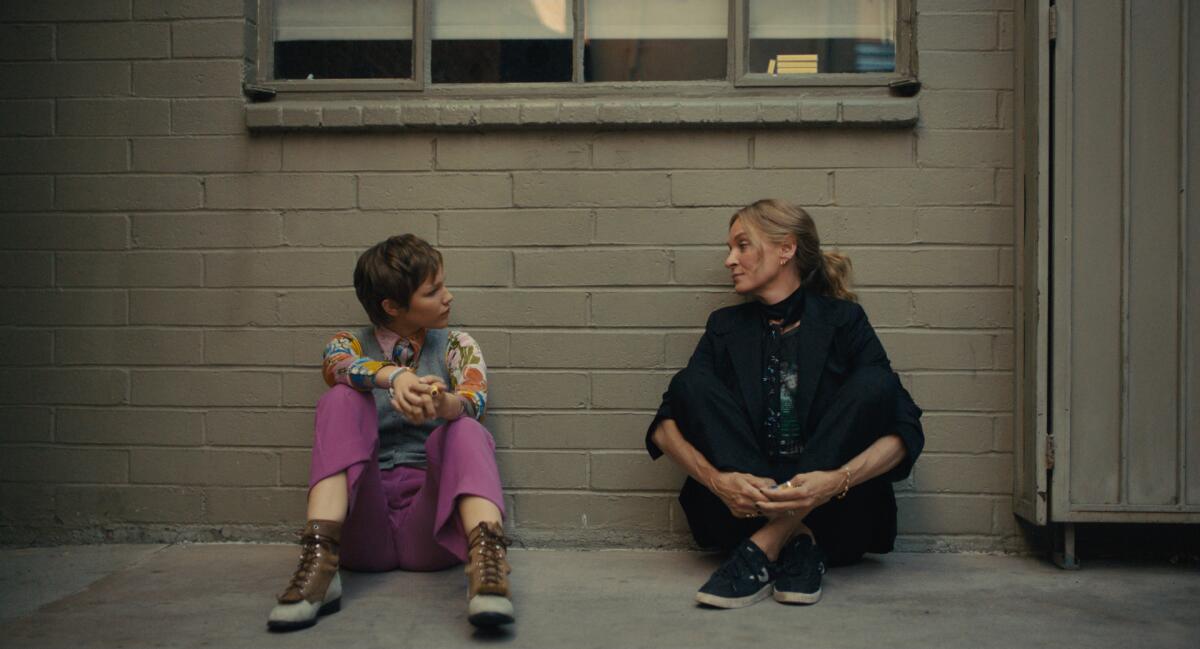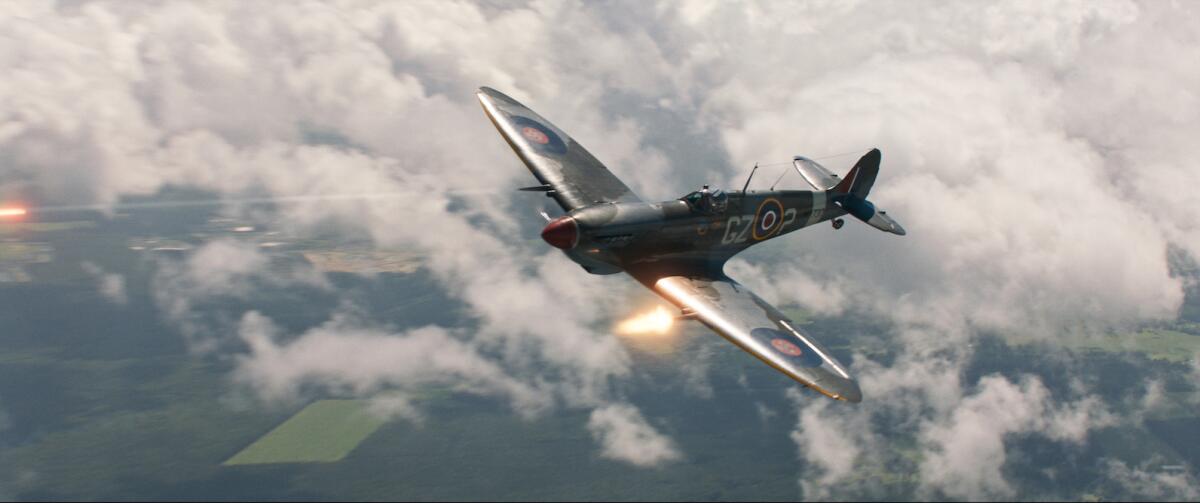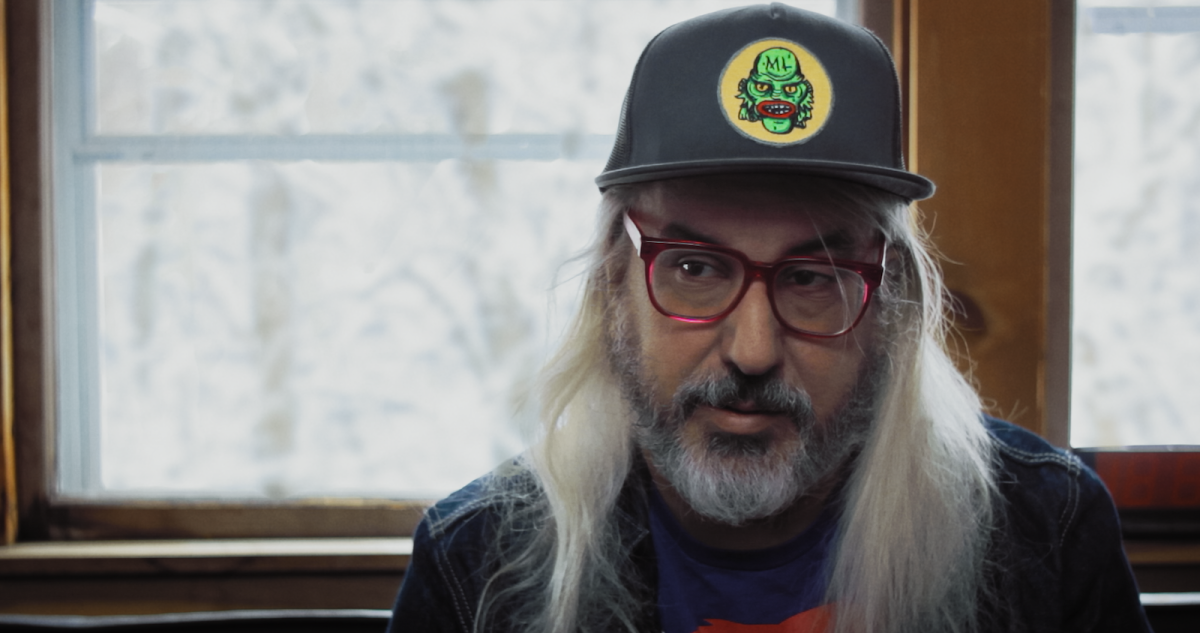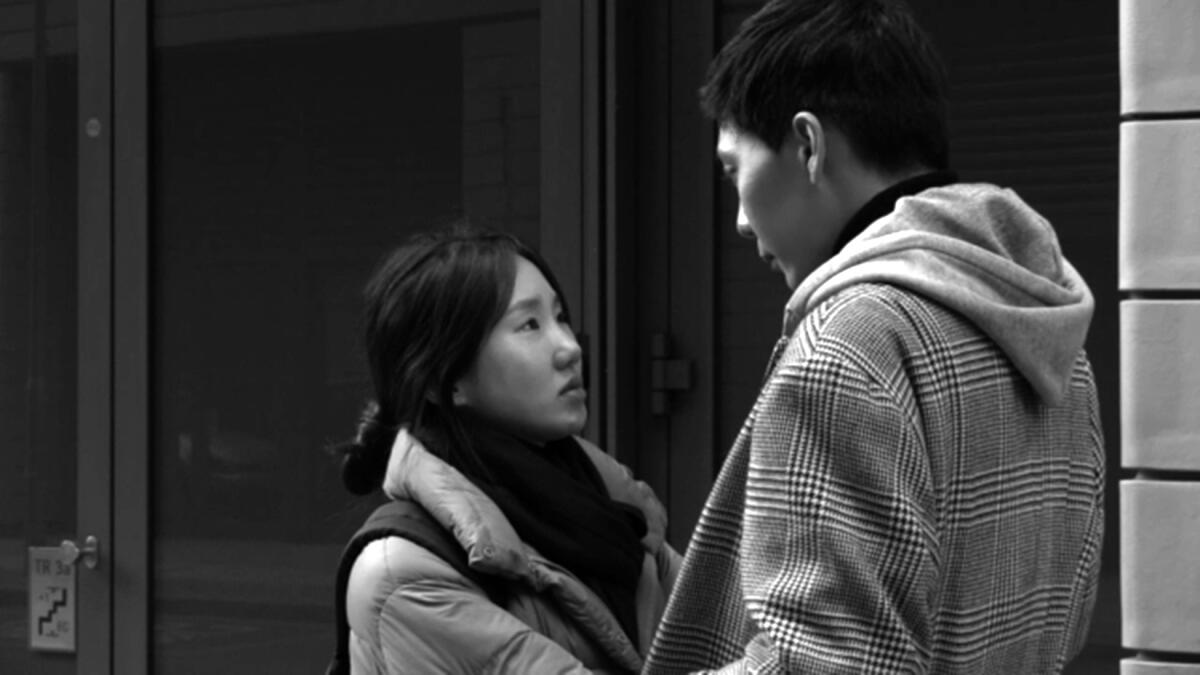Review: ‘Stargirl’ gets a sequel on Disney+, WWII flyboys and more movies to watch

- Share via
‘Hollywood Stargirl’
The 2020 Disney+ original movie “Stargirl” was a delightful surprise, adapting Jerry Spinelli’s cult-favorite young-adult novel in a way that matched its teenage heroine’s quirky, nonconformist vibe with a low-key indie-film feel — very different from the usual broad-stroke Disney sunniness. The sequel “Hollywood Stargirl” brings back the core creative team, including writer-director Julia Hart and her writer-producer husband, Jordan Horowitz, for an original story even more modestly scaled and amiable than its predecessor.
Grace VanderWaal returns as the title character: a ukulele-playing optimist and old-school pop music buff who follows her mother (Judy Greer) to Los Angeles, where she quickly gets involved in helping her neighbors Evan (Elijah Richardson) and Terrell (Tyrel Jackson Williams) make a sizzle reel for their independent movie project. As is her way, Stargirl also spreads her can-do spirit to two older acquaintances: a cranky retired Hollywood producer (Judd Hirsch) and a ’90s singer-songwriter (Uma Thurman) who never hit the big time.
Nothing that happens in “Hollywood Stargirl” is consequential or surprising. But the cast is likable, the music is good (featuring winning covers of canonical California songs like Brian Wilson’s “Love and Mercy” and Cass Elliot’s “Make Your Own Kind of Music”) and, as with “Stargirl,” there’s a bone-deep decency to this sequel that’s pretty disarming. This is a film about nice people funneling their positivity into something creative they hope will endure for decades, just like the music and movies they love.
‘Hollywood Stargirl.’ PG, for some mild language. 1 hour, 42 minutes. Available on Disney+

‘Wolf Hound’
It’s no “Top Gun: Maverick,” but filmgoers who have had their appetites whetted for high-flying military action might find a lot to like in “Wolf Hound,” a throwback World War II thriller loosely based on actual history. Directed by Michael B. Chait from a Timothy Ritchey screenplay, the movie stars James Maslow as U.S. bomber pilot David Holden, whose B-17 is shot down behind enemy lines. There he learns about the Nazis’ KG 200 unit, which has a plan to refashion his aircraft into a giant bomb, headed into Allied territories under Allied colors.
The KG 200 division of the Luftwaffe did exist, and was known for its unconventional use of planes, enemy and otherwise. But “Wolf Hound” doesn’t try to pass itself off as a “this is how it really was” docudrama. It’s an at times over-the-top piece of pulp fiction, with cartoonish villains and a ragtag band of one-dimensional heroes who say things like, “This is how we do it in Brooklyn!” before firing a rocket launcher.
Chait and company have a hard time coming up with enough plot to justify “Wolf Hound” stretching past two hours; and the long shootout scenes in the movie’s midsection do get taxing. But the extended aerial combat sequences at the start and end of the film are genuinely impressive for a non-blockbuster, and ought to grab the attention of genre aficionados. If the aim of this picture was to stage some thematically uncomplicated, eye-catching WWII action, then mission accomplished.
‘Wolf Hound.’ R, for violence. 2 hours, 10 minutes. Cinelounge Sunset, Hollywood; Lumiere Music Hall, Beverly Hills; also available on VOD
‘Dashcam’
Musician Annie Hardy gives a boldly abrasive performance in director Rob Savage’s experimental, semi-improvised horror film “Dashcam,” which takes the form of a series of livestreams from an unhinged internet provocateur. Hardy plays a version of herself: an independent artist named Annie who has spent the COVID-19 pandemic posting videos from her car of raunchy freestyle pop songs and rants about government overreach. When Annie jets off to London at the start of the film, she quickly rubs her hosts the wrong way with her refusal to wear a mask and her raging disrespect for other people’s boundaries.
Then an even bigger problem arises. Mid-webcast, Annie crosses paths with an invulnerable, bloodthirsty monster — all while her followers keep a running text commentary going up the side of the screen. Savage does a remarkably good job of staging shocking and gory horror sequences within his “shot on the fly on a cellphone” gimmick.
This very short movie doesn’t have much to say, outside of suggesting that even people who loudly and obnoxiously proclaim themselves to be independent thinkers are still vulnerable. Mainly, Savage and his co-writers Gemma Hurley and Jed Shepherd cultivate chaos, keeping viewers constantly unsure of what might happen next — and unsure of whether or not they’re ultimately rooting for Annie. The filmmakers and Hardy sharply capture a particular type: the performative rebel, laser-focused on pushing other people’s buttons even while fleeing a demon.
‘Dashcam.’ R, for bloody violence, pervasive language and crude sexual references throughout. 1 hour, 16 minutes. Alamo Drafthouse, downtown Los Angeles; Laemmle Noho 7, North Hollywood; also available on VOD

‘Freakscene: The Story of Dinosaur Jr.’
In the decade before the more mainstream, Seattle-born style of “grunge” took over rock ’n’ roll, a handful of bands pioneered their own take on the sound, combing classic rock riffs, avant-garde noise and punk energy. One of the least likely survivors of that era is Amherst, Mass.’ Dinosaur Jr., a power trio whose ferocious roar and dreamy melodies made them staples of college radio in the ’80s and then — unexpectedly — regulars on MTV for a few years in the ’90s. The original members reunited in 2005, and have continued to tour and release albums just as squalling and oddly beautiful as ever.
Director Philipp Virus’ documentary “Freakscene: The Story of Dinosaur Jr.” is more for the band’s longtime fans than for people who need to be persuaded of their greatness. The film has a lo-fi look and a shaggy structure, and because Dinosaur Jr.’s singer-guitarist-visionary J Mascis rarely speaks above a halting mumble, the doc’s pacing flags pretty much whenever he talks. But the electrifying old live footage and the more dialed-in interviewees (including peers Henry Rollins, Frank Black and Kim Gordon) pick up Mascis’ slack. And since Dinosaur Jr. was always a band for alt-rock connoisseurs, perhaps it’s fitting that this movie about them is equal parts heartfelt and ungainly.
‘Freakscene: The Story of Dinosaur Jr..’ Not rated. 1 hour, 22 minutes. Available on VOD
Also on streaming, VOD
“Joe Papp in Five Acts” is an enlightening 2012 documentary about the progressive New York theater producer, whose free Shakespeare in the Park series is celebrating its 60th anniversary this year. Featuring rare archival clips and frank interviews with the many A-list actors who worked for Papp, the film looks back at the radical changes the American theater went through from the 1950s through the ’80s. Available on PBS
“The Sanctity of Space” is the latest addition to the rich subgenre of nature documentaries about mountaineers attempting death-defying conquests. This stunning-looking film is set at and around Alaska’s Denali peak, and follows climbers maneuvering across the top of one of the mountain’s massifs. Available on VOD
Available now on DVD and Blu-ray

“Introduction” is the 25th movie directed by prolific Korean filmmaker Hong Sang-soo, who specializes in elliptical slice-of-life stories about people struggling to get on the same wavelength in their relationships. This film — shot in moody black-and-white — bounces between South Korea and Berlin, for a series of engaging vignettes in which characters talk around what they really mean to say. Cinema Guild
“1776” is the 1972 big-screen adaptation of the beloved Tony-winning musical, about how America’s Continental Congress bickered and bargained their way to the signing of the Declaration of Independence. The new Blu-ray edition includes an extended cut of the film, along with commentary tracks and deleted scenes, all of which help tell the story of how this pre-“Hamilton” historical pageant came to be. Sony
More to Read
Only good movies
Get the Indie Focus newsletter, Mark Olsen's weekly guide to the world of cinema.
You may occasionally receive promotional content from the Los Angeles Times.










